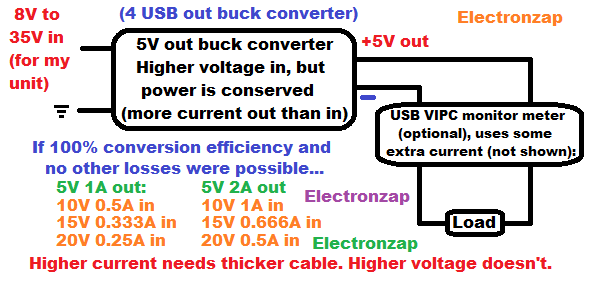Table of Contents
Buck converters take in a DC voltage that is higher than desired, and output a lower voltage that is desired. Power is mostly conserved though, because buck converters output more current than what is input.

Voltage regulators on the other hand, just waste power by converting the voltage drop to waste heat since the current in is the same as the current out.
That’s on top of whatever other current the regulator needs to operate.
When it comes to buck converters…
- Output voltage might be fixed.
- Output voltage might be digitally adjustable.
- Output voltage might be trimpot (or similarly) adjustable. You need to measure it before connecting a load if there is no digital display.
If a perfect conversion were possible, then the power (voltage times current) through the input would be exactly the same as the power (voltage times current) that the load draws from the output.
- At an impossible 100% efficiency, a load of 1A at 5V, will result in a 10V input having to provide 0.5A.
- 10V x 0.5A = 5W.
- 5V x 1A = 5W
An 80% efficient converter will output 0.8W for every watt that goes into it. A 95% efficient converter will output 0.95W for every watt put into it. Always keep in mind that manufacturers and sellers may lie about the efficiency of their converters.
USB chargers that you plug into a round automobile outlet, which used to be for a cigarette lighter, are a common buck converter. They take in approximately 12V from the outlet, and output approximately 5V from the USB port.
In the following video, I demonstrate a buck converter unit that can be clamped to almost any higher voltage battery terminals and output 5V from multiple USB ports.
Buck converters also come on circuit boards, but they are less common than boost converters on circuit boards. Boost converters do the opposite of a Buck converter. They take in a lower voltage, and output a higher voltage, while conserving power.
Other power conversion devices (and voltage regulators):
- Adapters: take in AC, and turn it into a lower voltage DC, while conserving as much power as possible.
- Boost converters: Take in a voltage that is lower than desired, and outputs a higher desired voltage, while conserving as much power as possible.
- Regulators: Take in a higher voltage than is desired, and outputs a lower voltage that is desired, but does not conserve power at all. They simply restrict current flow (like a self adjusting resistor) in order to hold a lower voltage across the load at the output. Voltage Regulator Basics
- Transformer: Step down – takes a higher voltage in and output a lower voltage. Step up – takes a lower voltage in and outputs a higher voltage. Power is conserved as much as possible, and changing AC voltage is much simpler than changing DC voltage.
- Inverter: Takes a DC voltage, which is usually lower than desired, and outputs an AC voltage that is high for basic electronics. Usually it is a voltage that commonly used in that area, such as 120VAC in the US, and 240VAC in much of the rest of the world. Power is conserved as much as possible.
Good topics to check out next:
To support this site, check out the following links:
- Check out my YouTube videos! https://www.youtube.com/c/Electronzap/videos
- Products I used in my videos or otherwise think look like a good buy. As an Amazon associate, I earn from qualifying purchases. My Amazon affiliate page showing products I think look good
- Information on this site is not guaranteed to be accurate. Always consult the manufacturer info/datasheet of parts you use. Research the proper safety precautions for everything you do.
- Electronzap is a participant in the Amazon Services LLC Associates Program, an affiliate advertising program designed to provide a means for sites to earn advertising fees by advertising and linking to amazon.com.